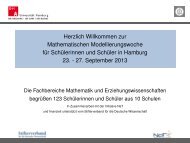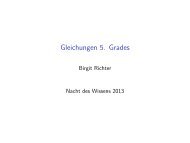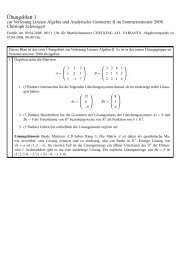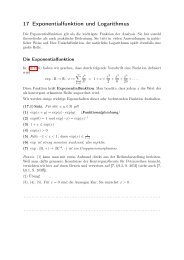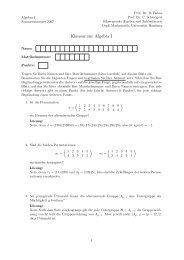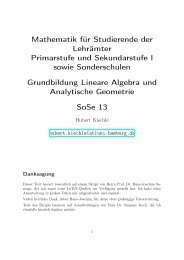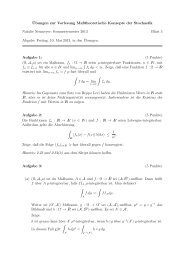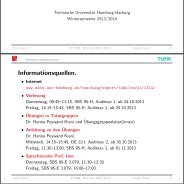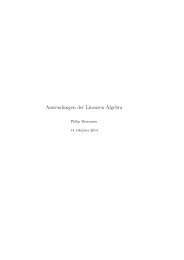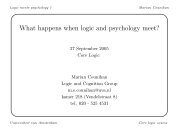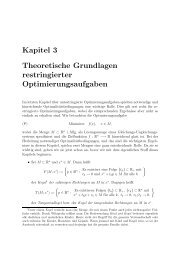pdf file
pdf file
pdf file
Create successful ePaper yourself
Turn your PDF publications into a flip-book with our unique Google optimized e-Paper software.
Remarks 4.1.2.<br />
1. Graphically, we represent the braiding by overcrossings and its inverse by undercrossings.<br />
Overcrossings and undercrossings have to be distinguished.<br />
2. The flip map<br />
τ : V ⊗ W → W ⊗ V<br />
v ⊗ w ↦→ w ⊗ v<br />
defines a symmetric braiding on the monoidal category vect(K) of K-vector spaces. It also<br />
induces a symmetric braiding on the category K[G]-mod of K-linear representations of a<br />
group. More generally, flip maps give a symmetric braiding on the category H−mod for<br />
any cocommutative Hopf algebra. Since the universal enveloping algebra U(g) of a Lie<br />
algebra g is cocommutative, the category of K-linear representations of g is symmetric,<br />
as well.<br />
3. There are tensor categories that do not admit a braiding. For example, for G a non-abelian<br />
group, the category vect(G) of G-graded vector spaces does not admit a braiding since<br />
are not isomorphic, if gh ≠ hg.<br />
K g ⊗ K h<br />
∼ = Kgh and K h ⊗ K g<br />
∼ = Khg<br />
4. The category vect(G) admits the flip as a braiding, if the group G is abelian. In the<br />
case of G = Z 2 , objects are Z 2 -graded vector spaces V 0 ⊕ V 1 . We can introduce another<br />
symmetric braiding c: on homogeneous vector spaces, it equals the flip, except for<br />
c : V 1 ⊗ W 1 → W 1 ⊗ V 1<br />
v 1 ⊗ w 1 ↦→ −w 1 ⊗ v 1<br />
This category is called the category of super vector spaces. In particular, a tensor category<br />
can admit inequivalent braidings.<br />
5. The monoidal category of cobordisms has disjoint union as the tensor product. It admits<br />
the morphism represented by the bordism of two cylinders exchanging the order of the<br />
two tensorands M 1<br />
∐<br />
M2 → M 2<br />
∐<br />
M1 as a symmetric braiding.<br />
Remarks 4.1.3.<br />
1. As in any tensor category, we can consider algebras and coalgebras in a braided tensor<br />
category (C, ⊗, c). Now, we have the notion of a commutative associative unital algebra<br />
(A, μ, η): here the product is required to obey μ ◦ c A,A = μ. We also have the opposed<br />
algebra with multiplication μ opp := μ◦c A,A . Similarly, we have the notion of the coopposed<br />
coalgebra with coproduct Δ copp := c C,C ◦Δ, and the notion of a cocommative coassociative<br />
counital coalgebra with coproduct obeying c C,C ◦ Δ = Δ.<br />
2. Another construction that uses the braiding is the following: Suppose that we have two<br />
associative unital algebras (A, μ, η) and (A ′ , μ ′ , η ′ ) in a braided tensor category C. Then<br />
the tensor product A ⊗ A ′ can be endowed with the structure of an associative algebra<br />
with product<br />
A ⊗ A ′ ⊗ A ⊗ A ′ id A⊗c A,A ′ ⊗id A ′<br />
−→<br />
A ⊗ A ⊗ A ′ ⊗ A ′ μ⊗μ′<br />
−→ A ⊗ A ′ .<br />
A unit is then η ⊗ η ′ .<br />
Dually, also the tensor product of two counital coassociative coalgebras can be endowed<br />
with the structure of a coalgebra.<br />
84




